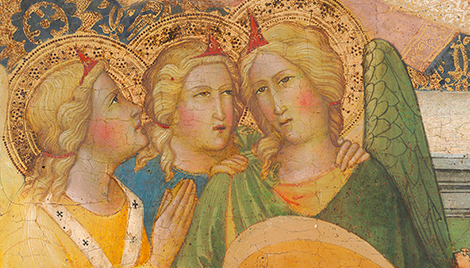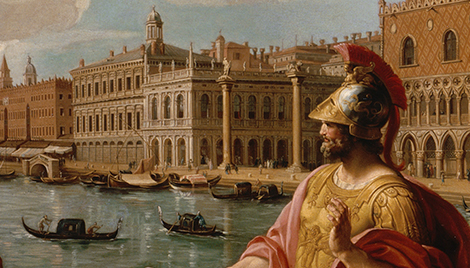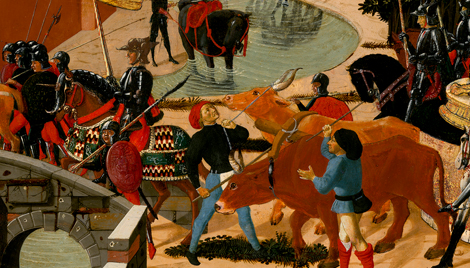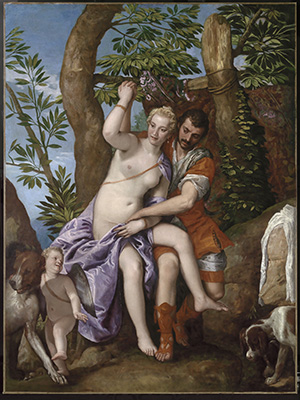Venus and Adonis
Venus and Adonis
- Artist
- Veronese and Workshop
- Artist Dates
- 1528-1588
- Artist Nationality
- Italian
- Title
- Venus and Adonis
- Date
- 1570s
- Medium
- oil on canvas
- Dimensions
- 224.4 x 168.3 cm (88-1/2 x 66-1/4 in)
- K Number
- K1552
- Repository
- Seattle Art Museum
- Accession Number
- 61.174
- Notes
Provenance
Acquired before 1648 by Monseigneur de Housset, French Ambassador in Venice. Pierre-Louis-Paul Randon de Boisset [1709-1776]; (his estate sale, Paris, 27 February 1777, no. 8); Jean-Baptiste-Pierre Lebrun [1748-1813], Paris. Sir Francis Lucas Cook [1844-1920], 2nd Bart., Doughty House, Surrey, England; by inheritance to Sir Herbert Frederick Cook [1868-1939], 3rd Bart., Doughty House; (Count Alessandro Contini Bonacossi [1878-1955], Rome-Florence); sold to the Samuel H. Kress Foundation on 11 July 1948; gift 1961 to the Seattle Art Museum, no. 61.174.
Catalogue Entry
Veronese and Workshop
Venus and Adonis
K1552
Seattle, Wash., Seattle Art Museum (It 37/V 5994.1), since 1954.(1) Canvas. 88 1/2 x 66 1/4 in. (224.4 x 168.3 cm.). Inscribed on rock at right: PAVLO CALIARO VEROÊS F.(2) Fair condition; body of Venus abraded; Adonis' leg much abraded; faces in good condition. Long attributed to the studio or school of Veronese, K1552 has recently attracted more favorable opinion, based partly on its appearance after cleaning and partly on the possible recognition of its earlier provenance.(3) This provenance would identify K1552 as (a) 'a new conception by Veronese of Adonis with Venus and Eros, who is holding back a greyhound,' which Ridolfi cites as acquired toward the mid-seventeenth century by Monseigneur de Housset, former ambassador to Venice;(4) and (b) a painting by Veronese sold in 1777 from the collection of Randon de Boisset, Paris.(5) The catalogue description of the composition of the painting in this second collection applies equally well to K1552: Venus and Adonis making love: a portrait of two life-size figures seated near some trees; a cupid looks on with a dog alongside and at the right another dog is drinking; on canvas, 7 ft. high by 5 ft. 5 in. wide.(6) Further, the size and composition of K1552 relate it closely to three well-known paintings by Veronese, the Mars and Venus United by Love in the Metropolitan Museum, New York, and the Wisdom and Strength and Virtue and Vice in the Frick Collection, New York. If by Veronese, K1552 would probably date about the same time as these three paintings, or a little earlier, not long before 1580. More sketchy in technique is Paolo's small painting of a similar composition in the Vienna Museum entitled Venus and Adonis, which probably dates after 1580. Such hesitancy as one may feel about the attribution of K1552 may be due to the unsatisfactory preservation of the picture. X-ray shows small losses of pigment throughout, especially in the faces and bodies.(7) The filling in of these losses and the complete restoration of the picture had taken place at some time before the reproduction was made for the 1913 edition of the Cook catalogue.(8) X-ray now reveals that the expression of Venus' mouth was originally much more satisfactory than at present, while well-preserved areas of the bodies appear in the X-ray to be more sensitively modeled than would be guessed from the general effect of the painting at present. As for the cupid, X-ray shows such drastic losses as would seem to preclude a clear notion of its original appearance. The X-rays may be profitably studied in comparison with those of the Metropolitan Museum Mars and Venus.(9) Provenance: Possibly Monseigneur de Housset, French Ambassador in Venice (acquired before 1648).(10) Probably M. Randon de Boisset, Paris (sold, Remy's, Paris, Feb. 27, 1777, to Lebrun).(11) Cook Collection, Richmond, Surrey (catalogue, 1903, p. 40, as studio of Veronese; T. Borenius ed., vol. I, 1913, no. 175, as school of Veronese; M. W. Brockwell ed., 1932, p. 82, as school of Veronese, possibly Carlo Cagliari). Contini Bonacossi, Florence. Kress acquisition, 1948 –exhibited, after acquisition by Seattle Art Museum: 'Art Treasures for America,' National Gallery of Art, Washington, D.C., Dec. 10, 1961-Feb. 4, 1962, no. 99, as Veronese.
References
(1) Catalogue by W. E. Suida, 1954, pp. 52 ff., as Veronese. (2) T. Borenius (loc. cit. in Provenance) thought the inscription looked like a later addition. Suida (loc. cit. in note 1, above) believed it to be genuine. It does not seem to be very similar to Veronese's few known signatures; cf. the Hermes, Herse and Aglauros in the Fitzwilliam Museum, Cambridge (reproduced in Apollo, vol. LXXXIII, 1966, pl. VI), and the Mars and Venus in the Metropolitan Museum, New York. (3) In the catalogues of the Cook Collection, K1552 was attributed to the studio or school of Veronese (sec Provenance). In his 1932 and 1936 Lists B. Berenson labels it school of Veronese; in the 1957 ed., p. 136, he enters it as 'Veronese in great part,' while R. Longhi (in ms. opinion, 1948) considers it a fine example of Veronese, as does Suida (see note 1, above), who connects it with a passage in Ridolfi and an entry in the collection of Randon de Boisset. R. Marini (Veronese, French ed., 1970, p. 120, no. 200) seems to accept it tentatively as Veronese. (4) C. Ridolfi, Le Maraviglie dell' arte, 1648, D. von Hadeln ed., vol. I, 1914, pp. 336 f. (5) P. Remy, Catalogue des tableaux ... du cabinet de Jeu M. Randon de Boisset, Paris, Feb. 27, 1777, no. 8, as Paolo Veronese. (6) No.8: 'Les Amours de Venus & d'Adonis: on prétend que c'est le portrait de Calliari & celui de sa femme. Ces deux figures son de proportion naturelle, & assises allprès de plusieurs arbres: un Amour les regarde, un chien est à côté; à droite un autre chien qui boit. Ce tableau est d'autant plus estimable, que nous croyons pouvoir assurer qu'il est presque impossible de trouver un morceau qui réunisse plus d'agréments. Il est peint sur une toile de 7 pieds de haut, sur 5 pieds 5 pouces de large.' Suida (loc. cit. in note 1, above) says that a much abbreviated text of this catalogue gives incorrect measurements. (7) When the picture was restored is unknown –at least before it was reproduced in the 1913 Cook catalogue. (8) See Provenance. (9) X-rays of the latter are published by A. Burroughs, in Metropolitan Museum Studies, vol. III, pt. I, 1930, pp. 50 ff. (10) See notes 3 and 4, above. (11) See notes 5 and 6, above. An annotation in a copy of the Randon de Boisset catalogue in the Frick Art Reference Library, New York, indicates that the painting was bought by the picture dealer Lebrun for 2401 livres.






